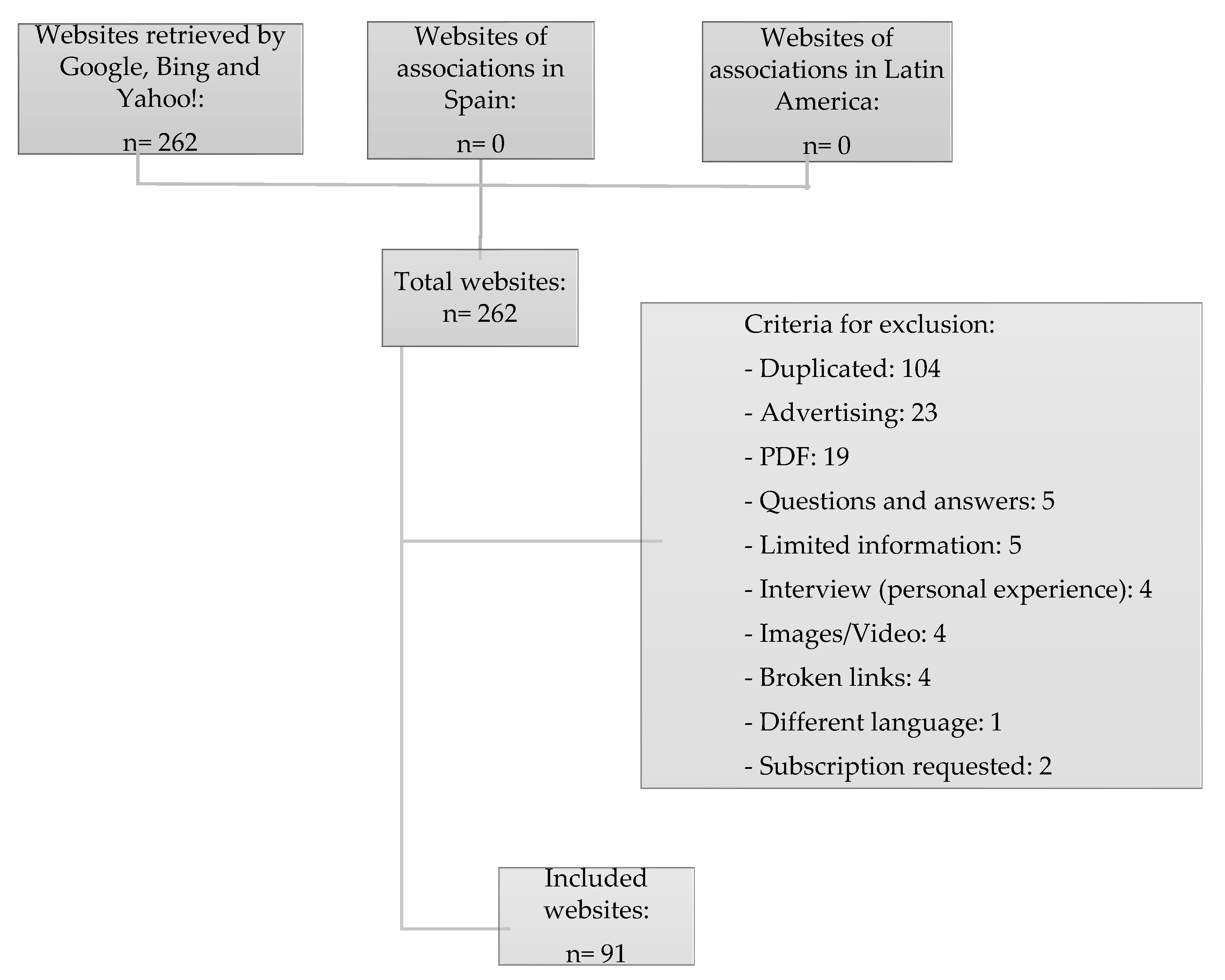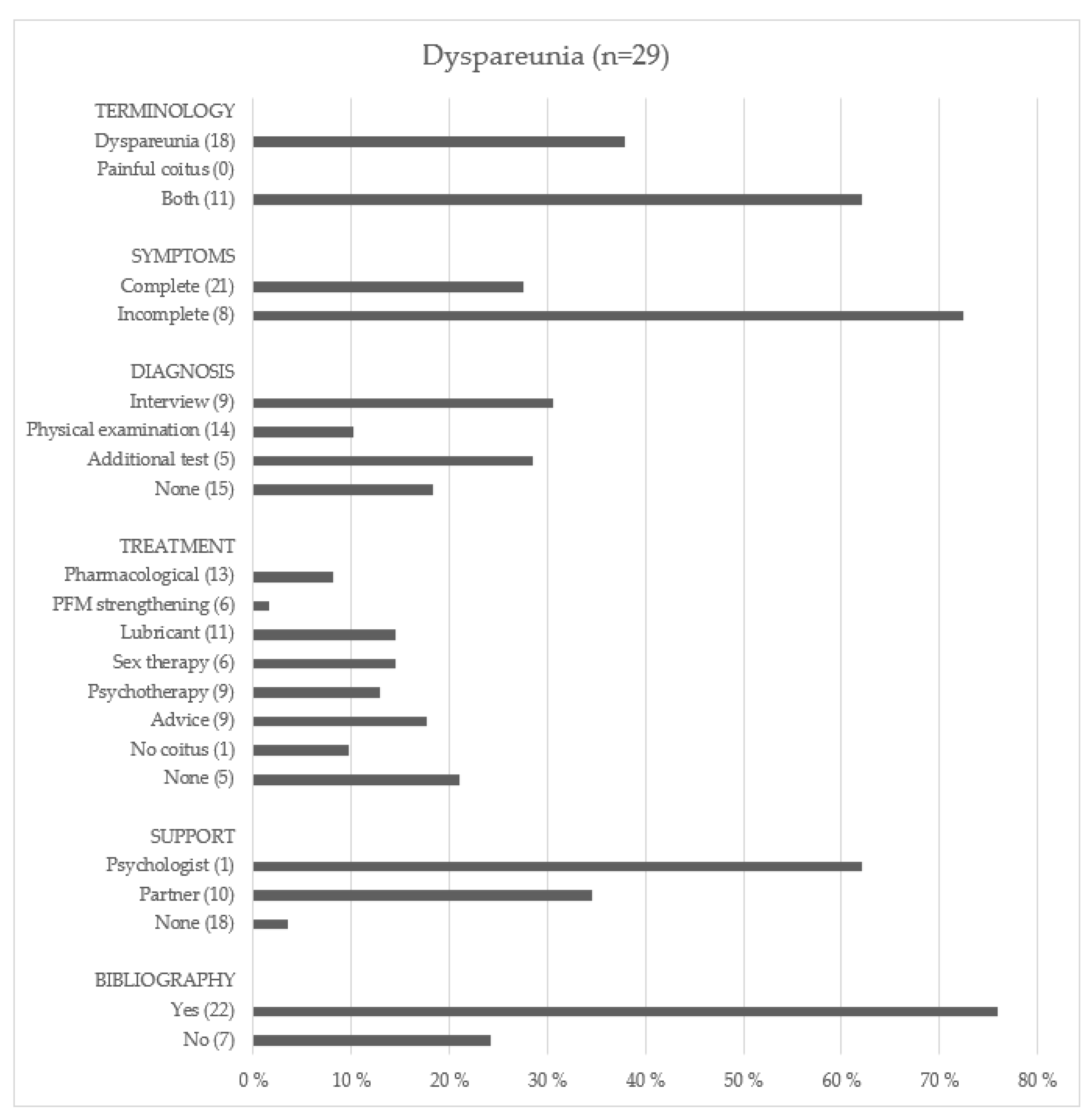Online Information on Painful Sexual Dysfunction in Women: Quality Analysis of Websites in SPANISH about Dyspareunia, Vaginismus and Vulvodynia
Abstract
:1. Introduction
2. Materials and Methods
2.1. Study Design
2.2. Search Strategy
2.3. Criteria for the Selection of Websites
2.4. Tools for Web Page Analysis
2.5. Data Analysis
3. Results
3.1. Characteristics of the Included Websites
3.2. Type of Information in Websites
3.2.1. Dyspareunia
3.2.2. Vaginismus
3.2.3. Vulvodynia
3.3. Quality of Health Information
3.4. Quality of Websites
3.5. Readability of Websites
4. Discussion
4.1. Websites Characteristics
4.2. Type of Information
4.3. Quality of Health Information
4.4. Quality of Websites
4.5. Readability
4.6. Considerations to Improve Quality and Readability of FSD Websites
4.7. Limitations
5. Conclusions
Author Contributions
Funding
Institutional Review Board Statement
Informed Consent Statement
Data Availability Statement
Acknowledgments
Conflicts of Interest
References
- World Health Organization. Sexual Health; WHO: Geneva, Switzerland, 2022. Available online: https://www.who.int/health-topics/sexual-health#tab=tab_1 (accessed on 16 November 2021).
- Berghmans, B. Physiotherapy for pelvic pain and female sexual dysfunction: An untapped resource. Int. Urogynecol. J. 2018, 29, 631–638. [Google Scholar] [CrossRef] [PubMed] [Green Version]
- Al-Abbadey, M.; Liossi, C.; Curran, N.; Schoth, D.E.; Graham, C.A. Treatment of female sexual pain disorders: A systematic review. J. Sex Marital. Ther. 2016, 42, 99–142. [Google Scholar] [CrossRef] [PubMed]
- Engeler, D.; Baranowski, A.P.; Borovicka, J.; Dinis-Oliveira, P.; Elneil, S.; Hughes, J.; Messelink, E.J.; Williams, A.C.d.C. EAU Guidelines on Chronic Pelvic Pain; European Association of Urology: Arnhem, The Netherlands, 2018; pp. 1–82. [Google Scholar]
- American Psychiatric Association. DSM-5. Manual Diagnóstico y Estadístico de los Trastornos Mentales, 5th ed.; Editorial Médica Panamericana: Madrid, Spain, 2014. [Google Scholar]
- Mitchell, K.R.; Geary, R.; Graham, C.A.; Datta, J.; Wellings, K.; Sonnenberg, P.; Field, N.; Nunns, D.; Bancroft, J.; Jones, K.G.; et al. Painful sex (dyspareunia) in women: Prevalence and associated factors in a British population probability survey. BJOG 2017, 124, 1689–1697. [Google Scholar] [CrossRef] [PubMed] [Green Version]
- Lee, N.M.W.; Jakes, A.D.; Llo Frodsham, L.C.G. Dyspareunia. BMJ 2018, 361, k2341. [Google Scholar] [CrossRef] [PubMed]
- Bornstein, J.; Goldstein, A.T.; Stockdale, C.K.; Bergeron, S.; Pukall, C.; Zolnoun, D.; Coady, D.; Bornstein, J.; Goldstein, A.; Zolnoun, D.; et al. 2015 ISSVD, ISSWSH and IPPS Consensus Terminology and Classification of Persistent Vulvar Pain and Vulvodynia. Obstet. Gynecol. 2016, 127, 745–751. [Google Scholar] [CrossRef] [PubMed]
- Reed, B.D.; Harlow, S.D.; Sen, A.; Legocki, L.J.; Edwards, R.M.; Arato, N.; Haefner, H.K. Prevalence and demographic characteristics of vulvodynia in a population-based sample. Am. J. Obstet. Gynecol. 2012, 206, 170. [Google Scholar] [CrossRef] [PubMed] [Green Version]
- Basson, R.; Althof, S.; Davis, S.; Fugl-Meyer, K.; Goldstein, I.; Leiblum, S.; Meston, C.; Rosen, R.; Wagner, G. Summary of the recommendations on sexual dysfunctions in women. J. Sex. Med. 2004, 1, 24–34. [Google Scholar] [CrossRef] [PubMed]
- Spector, I.P.; Carey, M.P. Incidence and prevalence of the sexual dysfunctions: A critical review of the empirical literature. Arch. Sex. Behav. 1990, 19, 389–408. [Google Scholar] [CrossRef] [PubMed]
- Lahaie, M.-A.; Amsel, R.; Khalifé, S.; Boyer, S.; Faaborg-Andersen, M.; Binik, Y.M. Can Fear, Pain, and Muscle Tension Discriminate Vaginismus from Dyspareunia/Provoked Vestibulodynia? Implications for the New DSM-5 Diagnosis of Genito-Pelvic Pain/Penetration Disorder. Arch. Sex. Behav. 2014, 44, 1537–1550. [Google Scholar] [CrossRef] [PubMed]
- Sánchez-Sánchez, B.; Arranz-Martín, B.; Navarro-Brazález, B.; Vergara-Pérez, F.; Bailón-Cerezo, J.; Torres-Lacomba, M. How Do We Assess Patient Skills in a Competence-Based Program? Assessment of Patient Competences Using the Spanish Version of the Prolapse and Incontinence Knowledge Questionnaire and Real Practical Cases in Women with Pelvic Floor Disorders. Int. J. Environ. Res. Public Health 2021, 18, 2377. [Google Scholar] [CrossRef]
- Mandimika, C.L.; Murk, W.; McPencow, A.M.; Lake, A.; Wedderburn, T.; Collier, C.H.; Connell, K.A.; Guess, M.K. Knowledge of pelvic floor disorders in a population of community-dwelling women. Am. J. Obstet. Gynecol. 2014, 210, 165.e1–165.e9. [Google Scholar] [CrossRef]
- Neels, H.; Wyndaele, J.-J.; Tjalma, W.A.A.; De Wachter, S.; Wyndaele, M.; Vermandel, A. Knowledge of the pelvic floor in nulliparous women. J. Phys. Ther. Sci. 2016, 28, 1524–1533. [Google Scholar] [CrossRef] [PubMed] [Green Version]
- McMullan, M. Patients using the Internet to obtain health information: How this affects the patient-health professional rela-tionship. Patient. Educ. Couns. 2006, 63, 24–28. [Google Scholar] [CrossRef] [PubMed]
- Tan, S.S.-L.; Goonawardene, N. Internet Health Information Seeking and the Patient-Physician Relationship: A Systematic Review. J. Med. Internet Res. 2017, 19, e9. [Google Scholar] [CrossRef]
- Kingsberg, S.A.; Schaffir, J.; Faught, B.; Pinkerton, J.V.; Parish, S.J.; Iglesia, C.B.; Gudeman, J.; Krop, J.; Simon, J.A. Female Sexual Health: Barriers to Optimal Outcomes and a Roadmap for Improved Patient–Clinician Communications. J. Women’s Health 2019, 28, 432–443. [Google Scholar] [CrossRef] [PubMed] [Green Version]
- Feldhaus-Dahir, M. Female sexual dysfunction: Barriers to treatment. Urol. Nurs. 2009, 29, 81–86. [Google Scholar]
- Ozmen, H.E. Sexual myths and sexual dysfunctions. Psychiatr. World 1999, 3, 49–53. [Google Scholar]
- Erbil, N. Relationship between Sexual Myths and Sexual Function of Women. Int. J. Caring Sci. 2019, 12, 1570–1579. [Google Scholar]
- Charnock, D.; Shepperd, S.; Needham, G.; Gann, R. DISCERN: An instrument for judging the quality of written consumer health information on treatment choices. J. Epidemiol. Community Health 1999, 53, 105–111. [Google Scholar] [CrossRef] [Green Version]
- Alioshkin-Cheneguin, A.; Salvat-Salvat, I.; Romay-Barrero, H.; Torres-Lacomba, M. How good is online information on fibromyalgia? An analysis of quality and readability of websites on fibromyalgia in Spanish. BMJ Open 2020, 10, e037065. [Google Scholar] [CrossRef]
- Charnock, D. The DISCERN Handbook. Quality Criteria for Consumer Health Information on Treatment Choices; University of Oxford: Oxford, UK; The British Library: London, UK, 1998. [Google Scholar]
- Bermudez-Tamayo, C.; Jimenez-Pernett, J.; Garcia Gutierrez, J.F.; Azpilicueta Cengotitobengoa, I.; Milena Silva-Castro, M.; Babio, G.; Castaño, P. Questionnaire to evaluate health web sites according to European criteria. Aten Primaria 2006, 38, 268–274. [Google Scholar] [PubMed] [Green Version]
- Barrio-Cantalejo, I.M.; Simón-Lorda, P.; Melguizo, M.; Escalona, I.; Marijuan, M.I.; Hernando, P. Validación de la Escala INFLESZ para evaluar la legibilidad de los textos dirigidos a pacientes. In Anales del Sistema Sanitario de Navarra; Gobierno de Navarra, Departamento de Salud: Pamplona, Spain, 2008; Volume 31. [Google Scholar]
- Kouhi, A.; Dabiri, S.; Mohseni, A.; Kouchakinezhad Eramsadati, M. Evaluation of the Quality of Otolaryngology Information on Persian Websites. Iran. J. Otorhinolaryngol. 2020, 32, 237–241. [Google Scholar]
- Castillo-Ortiz, J.D.; Valdivia-Nuno, J.J.; Ramirez-Gomez, A.; Garagarza-Mariscal, H.; Gallegos-Rios, C.; Flores-Hernandez, G.; Hernandez-Sanchez, L.; Brambila-Barba, V.; Castaneda-Sanchez, J.J.; Barajas-Ochoa, Z.; et al. Readability, relevance and quality of the information in Spanish on the Web for patients with rheumatoid arthritis. Reumatol. Clin. 2017, 13, 139–144. [Google Scholar] [CrossRef] [PubMed]
- Schreuders, E.H.; Grobbee, E.J.; Kuipers, E.J.; Spaander, M.C.; Veldhuyzen van Zanten, S.J. Variable Quality and Readability of Patient-oriented Websites on Colorectal Cancer Screening. Clin. Gastroenterol. Hepatol. 2017, 15, 79–85. [Google Scholar] [CrossRef] [PubMed]
- Cisu, T.I.; Mingin, G.C.; Baskin, L.S. An evaluation of the readability, quality, and accuracy of online health information regarding the treatment of hypospadias. J. Pediatr. Urol. 2019, 15, 40. [Google Scholar] [CrossRef] [Green Version]
- Santoro, N.; Epperson, C.N.; Mathews, S.B. Menopausal Symptoms and Their Management. Endocrinol. Metab. Clin. 2015, 44, 497–515. [Google Scholar] [CrossRef] [Green Version]
- Vercellini, P.; Buggio, L.; Frattaruolo, M.P.; Borghi, A.; Dridi, D.; Somigliana, E. Medical treatment of endometriosis-related pain. Best Pract. Res. Clin. Obstet. Gynaecol. 2018, 51, 68–91. [Google Scholar] [CrossRef]
- Ghaderi, F.; Bastani, P.; Hajebrahimi, S.; Jafarabadi, M.A.; Berghmans, B. Pelvic floor rehabilitation in the treatment of women with dyspareunia: A randomized controlled clinical trial. Int. Urogynecol. J. 2019, 30, 1849–1855. [Google Scholar] [CrossRef] [Green Version]
- Wallace, S.L.; Miller, L.D.; Mishra, K. Pelvic floor physical therapy in the treatment of pelvic floor dysfunction in women. Curr. Opin. Obstet. Gynecol. 2019, 31, 485–493. [Google Scholar] [CrossRef]
- Reissing, E.D.; Binik, Y.M.; Khalifé, S.; Cohen, D.; Amsel, R. Vaginal spasm, pain, and behavior: An empirical investigation of the diagnosis of vaginismus. Arch. Sex. Behav. 2004, 33, 5–17. [Google Scholar] [CrossRef]
- Pacik, P.T. Understanding and treating vaginismus: A multimodal approach. Int. Urogynecol. J. 2014, 25, 1613–1620. [Google Scholar] [CrossRef]
- Negrin Perez, M.C. Colegio Mexicano de Especialistas en Ginecologla y Obstetricia. Clinical practice guideline. Female sexual dysfunctions: Sexual pain disorders. Ginecol. Obstet. Mex. 2010, 78, 527. [Google Scholar]
- Bergeron, S.; Meana, M.; Yitzchak, B.; Khalife, S. Handbook of Clinical Sexuality for Mental Health Professionals, 2nd ed.; Levine, S.B., Ed.; Routledge: New York, NY, USA, 2010. [Google Scholar]
- Fadul, R.; Garcia, R.; Zapata-Boluda, R.; Aranda-Pastor, C.; Brotto, L.; Parron-Carreno, T.; Alarcon-Rodriguez, R. Psychosocial Correlates of Vaginismus Diagnosis: A Case-Control Study. J. Sex Marital Ther. 2019, 45, 73–83. [Google Scholar] [CrossRef] [PubMed]
- Fugl-Meyer, K.S.; Bohm-Starke, N.; Damsted Petersen, C.; Fugl-Meyer, A.; Parish, S.; Giraldi, A. Standard operating procedures for female genital sexual pain. J. Sex. Med. 2013, 10, 83–93. [Google Scholar] [CrossRef] [PubMed]
- Van Lankveld, J.J.; ter Kuile, M.M.; de Groot, H.E.; Melles, R.; Nefs, J.; Zandbergen, M. Cognitive-behavioral therapy for women with lifelong vaginismus: A randomized waiting-list controlled trial of efficacy. J. Consult. Clin. Psychol. 2006, 74, 168–178. [Google Scholar] [CrossRef] [PubMed]
- Boyer, S.C.; Goldfinger, C.; Thibault-Gagnon, S.; Pukall, C.F. Management of female sexual pain disorders. Adv. Psychosom. Med. 2011, 31, 83–104. [Google Scholar] [PubMed]
- Goldstein, A.T.; Pukall, C.F.; Brown, C.; Bergeron, S.; Stein, A.; Kellogg-Spadt, S. Vulvodynia: Assessment and Treatment. J. Sex. Med. 2016, 13, 572–590. [Google Scholar] [CrossRef]
- Leo, R.J. A systematic review of the utility of anticonvulsant pharmacotherapy in the treatment of vulvodynia pain. J. Sex. Med. 2013, 10, 2000–2008. [Google Scholar] [CrossRef]
- Rosen, N.O.; Dawson, S.J.; Brooks, M.; Kellogg-Spadt, S. Treatment of Vulvodynia: Pharmacological and Non-Pharmacological Approaches. Drugs 2019, 79, 483–493. [Google Scholar] [CrossRef]
- Touchet, B.K.; Warnock, J.K.; Yates, W.R.; Wilkins, K.M. Evaluating the quality of websites offering information on female hypoactive sexual desire disorder. J. Sex Marital Ther. 2007, 33, 329–342. [Google Scholar] [CrossRef]
- Seidman, J.J.; Steinwachs, D.; Rubin, H.R. Design and testing of a tool for evaluating the quality of diabetes consumer-information Web sites. J. Med. Internet Res. 2003, 5, e30. [Google Scholar] [CrossRef] [PubMed]
- Beatriz-Navarro, B.; Vergara-Pérez, F.; Prieto-Gómez, V.; Sánchez-Sánchez, B.; Yuste-Sánchez, Y.S.; Torres-Lacomba, M. What influences women to adhere to pelvic floor exercises after 2 physiotherapy treatment? A qualitative study for individualized pelvic health care. J. Pers. Med. 2021, 11, 1368. [Google Scholar] [CrossRef] [PubMed]
- Torres-Lacomba, M.; Navarro-Brazález, B.; Yuste-Sánchez, M.J.; Sánchez-Sánchez, B.; Prieto-Gómez, V.; Vergara-Pérez, F. Women´s experiences on compliance of pelvic floor home exercises therapy and lifestyles changes for pelvic organ prolapse symptoms: A qualitative study. J. Pers. Med. 2022. under review. [Google Scholar]
- De la Torre Barbero, M.J.; Estepa Luna, M.J.; Lopez-Pardo Martinez, M.; Leon Marquez, M.; Sanchez Laguna, F.; Toledano Redondo, S. Evaluation of the Andalusia Public Health System hospital websites in the period 2010–2012. Rev. Calid. Asist. 2014, 29, 127–134. [Google Scholar] [CrossRef]
- Hernandez-Morante, J.J.; Jimenez-Rodriguez, D.; Canavate, R.; Conesa-Fuentes, M.C. Analysis of Information Content and General Quality of Obesity and Eating Disorders Websites. Nutr. Hosp. 2015, 32, 606–615. [Google Scholar]
- Fernández-Aranda, M.I. Evaluación de calidad de páginas web sobre obstetricia y ginecología para las gestantes de atención primaria. Matronas Prof. 2016, 17, 149–156. [Google Scholar]
- Mazmudar, R.S.; Sheth, A.; Tripathi, R.; Scott, J.F. Readability of online Spanish patient education materials in dermatology. Arch. Dermatol. Res. 2021, 313, 201–204. [Google Scholar] [CrossRef] [PubMed]
- Padilla-Garrido, N.; Aguado-Correa, F.; Huelva-López, L.; Ortega-Moreno, M. Comparative analysis of quality labels of health websites. Rev. Calid. Asist. 2016, 31, 212–219. [Google Scholar] [CrossRef]
- Fernández-Vítores, D. El Español: Una Lengua Viva; Informe 2021; Instituto Cervantes: Madrid, Spain, 2021. [Google Scholar]




| Dyspareunia | Vaginismus | Vulvodynia | |
|---|---|---|---|
| Median (IQI) | |||
| Readability of the publication | 13 (19–11) | 12 (17.5–11) | 13.5 (19.25–10) |
| Quality of information on treatment options | 9 (12.5–7) | 9.5 (12–8) | 9 (10.25–8) |
| Overall score | 1 (1–1) | 1 (1–1) | 1 (1–1) |
| Total score | 24 (30–21) | 23.5 (30–20) | 25.5 (30–20) |
| Dyspareunia | Vaginismus | Vulvodynia | |
|---|---|---|---|
| Median (IQI) | |||
| Transparence and absence of conflict of interests | 12 (13–9) | 12 (13.75–10.25) | 12 (13–11) |
| Authorship | 3 (4–3) | 3 (4–2) | 3 (6–2) |
| Personal data protection | 3 (3–3) | 3 (3–3) | 3 (3–3) |
| Information updating | 1 (1–1) | 1 (1–1) | 1 (1–1) |
| Responsibility | 6 (6–5) | 6 (6–5) | 6 (6–4.75) |
| Accessibility | 14 (16–14) | 14 (16–11.5) | 14 (15–12) |
| Total score | 38 (41–35.5) | 37 (42–35) | 38 (43–33.75) |
Publisher’s Note: MDPI stays neutral with regard to jurisdictional claims in published maps and institutional affiliations. |
© 2022 by the authors. Licensee MDPI, Basel, Switzerland. This article is an open access article distributed under the terms and conditions of the Creative Commons Attribution (CC BY) license (https://creativecommons.org/licenses/by/4.0/).
Share and Cite
Vicente-Neira, A.; Prieto-Gómez, V.; Navarro-Brazález, B.; Lirio-Romero, C.; Bailón-Cerezo, J.; Torres-Lacomba, M. Online Information on Painful Sexual Dysfunction in Women: Quality Analysis of Websites in SPANISH about Dyspareunia, Vaginismus and Vulvodynia. Int. J. Environ. Res. Public Health 2022, 19, 1506. https://doi.org/10.3390/ijerph19031506
Vicente-Neira A, Prieto-Gómez V, Navarro-Brazález B, Lirio-Romero C, Bailón-Cerezo J, Torres-Lacomba M. Online Information on Painful Sexual Dysfunction in Women: Quality Analysis of Websites in SPANISH about Dyspareunia, Vaginismus and Vulvodynia. International Journal of Environmental Research and Public Health. 2022; 19(3):1506. https://doi.org/10.3390/ijerph19031506
Chicago/Turabian StyleVicente-Neira, Andrea, Virginia Prieto-Gómez, Beatriz Navarro-Brazález, Cristina Lirio-Romero, Javier Bailón-Cerezo, and María Torres-Lacomba. 2022. "Online Information on Painful Sexual Dysfunction in Women: Quality Analysis of Websites in SPANISH about Dyspareunia, Vaginismus and Vulvodynia" International Journal of Environmental Research and Public Health 19, no. 3: 1506. https://doi.org/10.3390/ijerph19031506
APA StyleVicente-Neira, A., Prieto-Gómez, V., Navarro-Brazález, B., Lirio-Romero, C., Bailón-Cerezo, J., & Torres-Lacomba, M. (2022). Online Information on Painful Sexual Dysfunction in Women: Quality Analysis of Websites in SPANISH about Dyspareunia, Vaginismus and Vulvodynia. International Journal of Environmental Research and Public Health, 19(3), 1506. https://doi.org/10.3390/ijerph19031506










